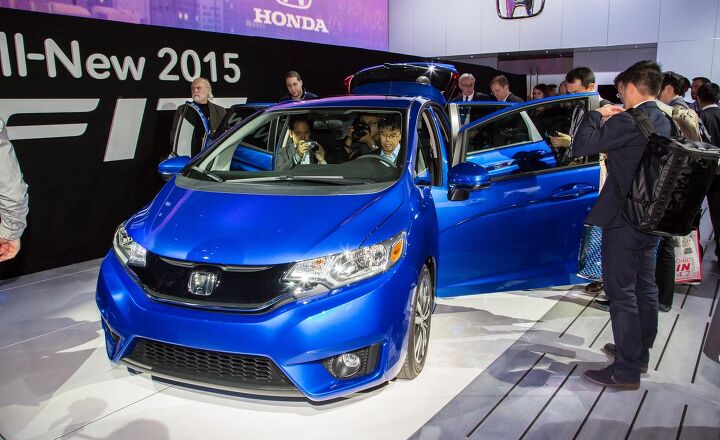Mexico Besting Japan, Canada In Auto Exports To The U.S.
Mexico’s auto industry is set to ship more product north to the United States than Japan and Canada by the end of 2015, in part due to the effects the North American Free Trade Agreement has had on the country since its signing two decades ago.
USA Today reports that with operations at Honda’s new $800 million plant in Guanajuato now online, the 200,000 Fits destined annually for the U.S. will push total Mexican exports to 1.7 million units this year, just 200,000 more than Japan’s exports from their home market. Mazda’s newest plant 25 miles away, when open this week, will add 230,000 units annually to the total, pushing Mexico past Canada by the end of 2015 to become the No. 1 exporter to the U.S.
At the time of NAFTA’s signing, the auto industry in Mexico produced 6 percent of the total output in North America. Twenty years later, that figure is now 19 percent, with 3 million units leaving the factory floor. Total valuation of the nation’s exports surged to $70.6 billion from $40 billion in 2007. The industry is now Mexico’s primary source of foreign currency, surpassing oil exports and remittances from migrant labor along the way.
This growth is driven by low wages — $16/day on average for Mexico’s 580,000 auto workers — which critics attribute to maintaining Mexico’s poverty rate between 40 percent and 50 percent two decades on. Meanwhile, the nation hasn’t fared any better as a whole, with overall economic growth at 1.1 percent in 2013, the worst rate of growth since the beginning of the Great Recession.
For Eduardo Solis, president of the Mexican Automotive Industry Association, the boom is about more than low wages, citing a new generation of local engineers and increases in automotive research as positive outcomes:
It’s not only about lower salaries. That’s short-sighted. It is a component of a larger equation that has to do with the expertise we are developing.
Aside from NAFTA opening the floodgates, the lack of tariffs has allowed Japanese manufacturers — the main driver behind new production in Mexico — to set up shop easily. Incentives from local governments, such as employee training, tax exemptions and infrastructure improvements, have helped to draw new factories to their cities.
Correction: an earlier iteration mistakenly quoted Mexican auto ages at $16 per hour.
Seattle-based writer, blogger, and photographer for many a publication. Born in Louisville. Raised in Kansas. Where I lay my head is home.
More by Cameron Aubernon
Latest Car Reviews
Read moreLatest Product Reviews
Read moreRecent Comments
- 3-On-The-Tree I have a 2009 C6 Corvette LS3 and the only major repair that I have done on it was replace the radiator. Besides usual plugs, wires oil etc. And yes those tires are expensive as well.
- 28-Cars-Later We had a red 2003 with less than 100 miles in late 2004/5ish and kept it till the end AFAIK. I do recall being told we had about $28,000 in at the time (about $43,6 in 2023 Clown World Bux). I don't ever recall anyone retail even looking at it, and it lived in the showroom/garage."It's an automatic that just had the linkage repaired and upgraded"This really doesn't bode well. Maybe there's a upgrade I'm simply not aware of so one could tune the 3rd Gen LM4 for higher power but messing with it isn't making me smile because now I know its no longer factory or somehow it broke and with such low miles I'm equally concerned.
- Analoggrotto With Kia Hyundai you are guaranteed to have the best Maintenance and Service experience in the industry. Complementary diagnostics, open book fees schedules and adherence to published rates with no attempts to tack extra work on are part of the HMC Gold Standard of Service. Recalls are the lowest in the industry but when you bring your Hyundai Genesis Kia vehicle in for Feature Improvement, rest assured that it will be taken care of to the highest pentagon standards, fully free of charge with no pressure for paid work or service unless requested. Hyundai Kia have the highest levels of customer ATP loyalty in the industry and Service is key to the best after sales experience.
- MaintenanceCosts In Toyota's hands, these hybrid powertrains with a single motor and a conventional automatic transmission have not been achieving the same kind of fuel economy benefits as the planetary-gear setups in the smaller cars. It's too bad. Many years ago GM did a group of full-size pickups and SUVs with a 6.0L V8 and a two-motor planetary gear system, and those got the fuel economy boost you'd expect while maintaining big-time towing capacity. Toyota should have done the same with its turbo four and six in the new trucks.
- JMII My C7 isn't too bad maintain wise but it requires 10 quarts of expensive 0W-40 once a year (per GM) and tires are pricey due size and grip requirements. I average about $600 a year in maintenance but a majority of that is due to track usage. Brake fluid, brake pads and tires add up quickly. Wiper blades, coolant flush, transmission fluid, rear diff fluid and a new battery were the other costs. I bought the car in 2018 with 18k in mileage and now it has 42k. Many of the items mentioned are needed between 20k and 40k per GM's service schedule so my ownership period just happens to align with various intervals.I really need to go thru my service spreadsheet and put track related items on a separate tab to get a better picture of what "normal" cost would be. Its likely 75% of my spend is track related.Repairs to date are only $350. I needed a new XM antenna (aftermarket), a cargo net clip, a backup lamp switch and new LED side markers (aftermarket). The LEDs were the most expensive at $220.


































Comments
Join the conversation
It is amazing that domestic help is paid more than auto workers. Our maid is paid five dollars per hour. Gardeners are paid three dollars per hour in our area. Sixteen dollars per day sounds very low to me. The waiters in local restaurants are paid more than that. I do live in a resort area, but the people coming to the resort are Mexicanos, not US and Canadians like elsewhere in Mexico.
Well, was that not the idea of NAFTA?